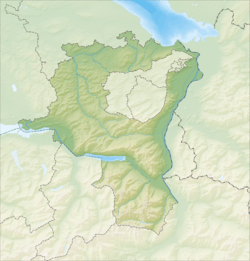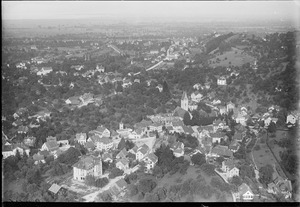Thal, St. Gallen facts for kids
Quick facts for kids
Thal
|
||
|---|---|---|
 |
||
|
||
| Country | Switzerland | |
| Canton | St. Gallen | |
| District | Wahlkreis Rorschach | |
| Area | ||
| • Total | 9.65 km2 (3.73 sq mi) | |
| Elevation | 415 m (1,362 ft) | |
| Population
(Dec 2020 )
|
||
| • Total | 6,722 | |
| • Density | 696.6/km2 (1,804.1/sq mi) | |
| Postal code |
9425
|
|
| Surrounded by | Fußach (AT-8), Gaißau (AT-8), Heiden (AR), Höchst (AT-8), Horn (TG), Lutzenberg (AR), Nonnenhorn (DE-BY), Rheineck, Rorschacherberg, Wasserburg (Bodensee) (DE-BY), Wolfhalden (AR) | |
Thal is a village and a municipality in Switzerland. It is located in the Wahlkreis (which means constituency or electoral district) of Rorschach. This area is part of the canton of St. Gallen. Besides the main village of Thal, the municipality also includes the villages of Altenrhein, Buechen, Buriet and Staad.
Contents
History of Thal
Thal was first mentioned in old records in the year 1163. It was called curtis tale back then.
The Weinburg was a very important building in the region. For many years, from 1419 to 1686, it was the home of important noble families. Later, from 1686 to 1772, it served as a county recorder's office. It even became important in Europe when it was the home of the Prince of Hohenzollern-Sigmaringen from 1817 to 1929.
After the First World War, the House of Hohenzollern-Sigmaringen family became less wealthy. Prince Friedrich von Hohenzollern had to sell the Weinburg estate. The Steyler Mission Society bought the building in 1929.
One year later, the Weinburg opened as Gymnasium Marienburg. It started as a mission school, then became a theological seminary, and finally a high school. The high school closed in the summer of 2012.
In 1983, a big cycling event called the UCI Road World Championships took place in Altenrhein. Altenrhein is one of the villages within the municipality of Thal.
Geography of Thal
Thal covers an area of about 9.6 square kilometers (3.7 square miles). A large part of this land, about 44%, is used for farming. Forests cover about 13.1% of the area. About 35.8% of the land has buildings or roads on it. The rest, about 7.2%, is made up of rivers or lakes.
Thal used to be part of the Unterrheintal District. In 2004, it became part of the Rorschach Wahlkreis. The municipality is located between the Appenzell foothills, the Buchberg mountain, and Lake Constance.
Thal is a haufendorf village. This means it's an unplanned village with buildings packed closely together around a central area. Since 1803, the municipality has also included the villages of Altenrhein, Buechen, Buriet, and Staad. There are also several small hamlets scattered around.
To the north and east, Thal shares a border with the old bed of the Rhine river, called Alter Rhein. It also borders Austria in these directions.
Thal's Coat of Arms
The blazon (a special description) of Thal's municipal coat of arms is: Argent a Grape Azure slipped embowed and leaved Vert.
This means the coat of arms shows a blue grape on a silver background. The grape has a green stem that is curved, and green leaves.
People of Thal (Demographics)
Thal has a population of about 6,000 people. About 18.9% of the people living in Thal are from other countries. Many of these foreign residents come from Germany, Italy, former Yugoslavia, and Austria.
Most people in Thal speak German, which is about 91.3% of the population. Other languages spoken include Albanian and Italian.
The population of Thal includes many young people. About 13.4% of the population are children aged 0 to 9 years old. Another 13.3% are teenagers aged 10 to 19.
Most adults in Thal live in families. About 55.8% of people live in a couple with children. About 22.5% are part of a couple without children. Some people, about 11.8%, live alone.
In the 2007 federal election, the most popular political party was the SVP. They received about 41.4% of the votes.
Many people in Thal have completed a good level of education. About 72.9% of adults aged 25–64 have finished high school or gone on to higher education, like university.
Here is a table showing how the population of Thal has changed over time:
| year | population |
|---|---|
| 1850 | 2,748 |
| 1900 | 3,546 |
| 1910 | 3,888 |
| 1930 | 3,625 |
| 1950 | 4,025 |
| 1970 | 4,919 |
| 1990 | 5,399 |
Transportation in Thal
Thal has good transportation links. The Staad railway station and Wartensee railway station are located here. There is also the Altenrhein airport.
A company called Stadler Rail has a factory in Altenrhein. They build trains for Switzerland and other countries. For example, they built new trains for the Glasgow Subway in Scotland and the Class 777 trains in England.
Economy of Thal
In Thal, people work in different types of jobs.
- The primary economic sector involves jobs like farming. About 95 people work in this sector.
- The secondary sector includes manufacturing and building things. About 1,717 people work in this area.
- The tertiary sector is about services, like shops, offices, and healthcare. About 1,327 people work in this sector.
Many people who live in Thal also work in the municipality. However, many residents travel outside Thal for their jobs. Also, many people from other places come to Thal for work.
Religion in Thal
Based on a census from 2000, many people in Thal are Christian. About 42.3% are Roman Catholic. Another 37.0% belong to the Swiss Reformed Church. There are also people who belong to other Christian churches, including the Orthodox Church.
About 4.94% of the population in Thal are Islamic. A small number of people are Jewish. About 7.59% of the population do not belong to any church or religion.
Places to See in Thal
The Schlosslandschaft Rorschach / Alter Rhein is a special area with many castles along the Rhine river. This area is recognized as part of the Inventory of Swiss Heritage Sites. This castle landscape is shared by Thal and several other nearby towns.
See also
 In Spanish: Thal (San Galo) para niños
In Spanish: Thal (San Galo) para niños






